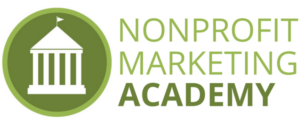If you are teetering on whether to invest time and energy into a Facebook nonprofit business page or a nonprofit group, consider which sounds more appealing…
Join my group! OR Follow my page.
We as humans are social beings. We are naturally group-oriented, especially for survival and belonging. This couldn’t be truer than it is in today’s highly social-focused culture. Therefore, Join my group! is a far more appealing call-to-action than Follow my page. In addition to our natural draw to groups, groups have a collective power that is not easily emulated on a social media business page.
Facebook groups specifically are an important part of nonprofit marketing, and in this post, we’ll share tips for creating a revenue-generating Facebook Group for your nonprofit.

1. Define a measurable revenue goal for your Nonprofit Facebook Group.
Most nonprofits have a limited marketing budget. Therefore, marketing tactics have to produce a return, or you need to move onto another tactic. Start developing your group by setting a measurable revenue goal and ensure it is time sensitive.
“Goal: generate $5,000 in donations from the Facebook Group each year.”
2. Find the perfect audience for your group.
One common mistake made with nonprofit marketing is trying to reach out to anyone and everyone and engage them with the nonprofit. There’s a reason that for-profit businesses don’t follow this approach with sales: it doesn’t work. Every product, every service, and every group has a specific audience. So a niche Facebook Group can help attract a targeted group of like-minded people who are ideally suited to support the nonprofit.
To find the right audience, start with researching those who already support the nonprofit. First, begin by examining your donors who donate frequently. Consistency with their donations indicates a connection and commitment.
Find your ideal audience through research:
What is their demographic makeup? Is this audience mostly a certain gender? Is there an average age?
Is there anything these donors seem to have in common? Are they employed in the same field or in similar fields? Are they retired? Do they all belong to a certain civic group?
After looking closely at this audience, do you see any group ideas?
Next, examine the clients or community sector your nonprofit serves. What other businesses are trying to reach this sector, and why? These businesses could be potential partners for your group or content sponsors. Do you see any group possibilities?
Finally, look for an audience in people who indirectly have something in common with your nonprofit work. Let’s look at an example. Consider Habitat for Humanity. This charity has many affiliate charities across the globe. Each affiliate charity could create a locally-focused Facebook Group with a goal to increase local donors and generate revenue.
So what is an ideal audience for a Habitat for Humanity group? One potential audience would be people interested in Do-It-Yourself (DIY) home improvement and design. This is an example of an audience that indirectly has something in common with the work of Habitat for Humanity.

Create a Facebook Group that indirectly ties with the work of the nonprofit.
Habitat for Humanity could create a group to share DIY design ideas, home improvement tips, interviews with local pros, how-to videos and more.
Revenue generation ideas:
- Generate revenue by creating a simple affiliate program website featuring popular home improvement tools and resources. Each time a group member makes a purchase, the nonprofit receives an affiliate link commission.
- Generate revenue from fundraising activities conducted directly in the group such as online silent auctions, online sales of products from the Habitat ReStore, and drawings by chance.
- Generate revenue through sponsored content such as sponsored Facebook Live events, content downloads, advertisement placements in the cover image area or social posts. (Some of this revenue may be considered taxable revenue.)
A DIY home improvement audience indirectly ties with the Habitat for Humanity mission and simultaneously helps Habitat for Humanity reach a broader audience.
3. Make the group content about the audience, not your nonprofit.
Much of nonprofit marketing is designed to share about the impact on the community and all the work the nonprofit is doing. However, keep your Facebook Group content all about the audience. Offer full disclosure with your group members using a simple tagline such as “This group [group name] is powered by [your nonprofit]. By joining this group, you’re having fun and making a difference!”
4. Enlist (and empower) an engaging administration team.
People like connecting with people, not business logos. To ensure success with your Facebook Group, enlist volunteers to serve as group administrators. Look for people with fun or humorous personalities who enjoy connecting with others. Create guidelines for administrators to follow, but don’t be so strict that you stifle their ability to engage with group members.
Take your Nonprofit Content Marketing to a new level!
A Facebook Group can be a powerful fundraising source for your nonprofit. It’s one of many lucrative tactics in a nonprofit content marketing strategy. Learn more ideas at our next leadership webinar: How To Use Nonprofit Content Marketing To Drastically Increase Donors. Click to save your seat!





